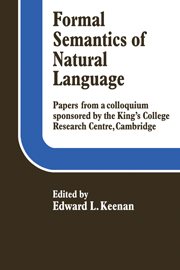Book contents
- Frontmatter
- Contents
- Notes on the contributors
- Acknowledgements
- Introduction
- I QUANTIFICATION IN NATURAL LANGUAGE
- II REFERENCE AND CROSS REFERENCE
- III INTENSIONAL LOGIC AND SYNTACTIC THEORY
- IV QUESTIONING MODEL THEORETIC SEMANTICS
- V PRAGMATICS AND SENTENCES IN CONTEXT
- Pragmatics in natural logic
- Changing the context
- Conditions of the use of sentences and a semantic representation of topic and focus
- Topics, sentence accent, ellipsis: a proposal for their formal treatment
- Preference semantics
- VI SEMANTICS AND SURFACE SYNTAX
Conditions of the use of sentences and a semantic representation of topic and focus
Published online by Cambridge University Press: 05 November 2011
- Frontmatter
- Contents
- Notes on the contributors
- Acknowledgements
- Introduction
- I QUANTIFICATION IN NATURAL LANGUAGE
- II REFERENCE AND CROSS REFERENCE
- III INTENSIONAL LOGIC AND SYNTACTIC THEORY
- IV QUESTIONING MODEL THEORETIC SEMANTICS
- V PRAGMATICS AND SENTENCES IN CONTEXT
- Pragmatics in natural logic
- Changing the context
- Conditions of the use of sentences and a semantic representation of topic and focus
- Topics, sentence accent, ellipsis: a proposal for their formal treatment
- Preference semantics
- VI SEMANTICS AND SURFACE SYNTAX
Summary
The main objective of this paper is to discuss the correspondence between the semantic structure of sentences and a structuring of the universe of discourse in a given time-point of the discourse.
Some possibilities of a classification of presuppositions, assertions and also allegations with respect to the distinction between a given world (state of affairs) and the points of reference (pragmatic context of an utterance token) are analysed in section 1. Chomsky's use of the term ‘presupposition’ is rejected as misleading, since the topic (i.e. the elements not belonging to the focus of the sentence) refers to items not only known, but activated in the given time-point of the utterance (section 2). Chomsky's range of permissible focus is shown to be determined by the hierarchy of communicative dynamism of the sentence (given by a systemic ordering of participants of verbs in the grammar and by contextual boundness); his choice of focus corresponds to the placement of the juncture between contextually bound and non-bound elements (section 3). If the scale of communicative dynamism of the participants of a verb is denoted, in semantic representation (SR), by a linear ordering of the participants, and the placement of boundness juncture is included, too, then – as demonstrated on crucial examples in section 4 – a semantically-based generative description can be formulated in which neither global constraints nor semantically relevant transformations are needed.
- Type
- Chapter
- Information
- Formal Semantics of Natural Language , pp. 297 - 312Publisher: Cambridge University PressPrint publication year: 1975
- 1
- Cited by



